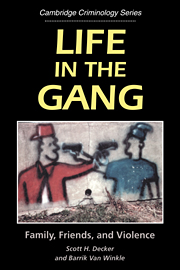Book contents
- Frontmatter
- Contents
- Acknowledgments
- Preface
- Chapter One Life in the Gang: Family, Friends, and Violence
- Chapter Two “Are You Claiming?” Methods of Study
- Chapter Three “I'm Down with the Bloods, What's up Cuz?” Membership Issues
- Chapter Four “We Ain't No Worldwide Thing or Nothing”: Gang Structure and Relationships
- Chapter Five “Where You Hanging? Let's Go Banging”: What Gang Members Do
- Chapter Six “I Love to Bang”: Serious Crime by Gang Members
- Chapter Seven “Doing Time” in School and Elsewhere: Gang Members and Social Institutions
- Chapter Eight “My Mom Doesn't Know”: Gang Members and Their Families
- Chapter Nine “There's Only Two Ways to Leave the Gang, Die or Move”: Responding to Gangs
- Notes
- References
- Index of Gang Members, Relatives, and Ex-Members
- Subject Index
Chapter Four - “We Ain't No Worldwide Thing or Nothing”: Gang Structure and Relationships
Published online by Cambridge University Press: 05 June 2012
- Frontmatter
- Contents
- Acknowledgments
- Preface
- Chapter One Life in the Gang: Family, Friends, and Violence
- Chapter Two “Are You Claiming?” Methods of Study
- Chapter Three “I'm Down with the Bloods, What's up Cuz?” Membership Issues
- Chapter Four “We Ain't No Worldwide Thing or Nothing”: Gang Structure and Relationships
- Chapter Five “Where You Hanging? Let's Go Banging”: What Gang Members Do
- Chapter Six “I Love to Bang”: Serious Crime by Gang Members
- Chapter Seven “Doing Time” in School and Elsewhere: Gang Members and Social Institutions
- Chapter Eight “My Mom Doesn't Know”: Gang Members and Their Families
- Chapter Nine “There's Only Two Ways to Leave the Gang, Die or Move”: Responding to Gangs
- Notes
- References
- Index of Gang Members, Relatives, and Ex-Members
- Subject Index
Summary
To be in a gang you have friends. It's kinda good to be with some friends instead of being out cause if you aint got no friends it's really hard to get along out there. If we in trouble they help you. (Male #009, “Marrien,” fifteen-year-old Compton Gangster)
To be with the in crowd, be with the fellas. We been together so long if they doing something, I'm doing it. I do something, they doing it. (Male #030, “Kenneth,” seventeen-year-old Thundercat)
THERE HAVE BEEN gangs in St. Louis since the end of the nineteenth century. Indeed, Thrasher (1927) makes numerous references to gangs in St. Louis, their influence on Chicago gangs, and the nature of their activities. Similar to other cities, St. Louis had a “gang problem” during the 1960s. However, this does not account for the presence of gangs in St. Louis in the 1990s. No member of our sample claimed that their gang was an extension or outgrowth of a St. Louis gang from an earlier era. Thus we must explain the origins of contemporary gangs and, in doing so, focus on the role of cultural transmission – the process of communicating the values, images, symbols, and behaviors common to gang members across the country.
Gang Origins
We examine two views about the origins of St. Louis gangs in the 1990s. The first view, more instrumental in nature, argues that gangs reemerged in the city from the purposive efforts of gang members in other cities to bring their gang to new cities.
- Type
- Chapter
- Information
- Life in the GangFamily, Friends, and Violence, pp. 85 - 116Publisher: Cambridge University PressPrint publication year: 1996



